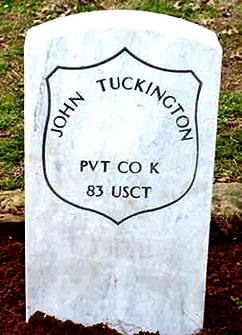But, the one state that held the record however, for having produced the largest number of black Union soldiers was Louisiana, and most of the black men in these regiments served prior to the establishment of the US Colored Troops which took place in 1863. Among them were the men who formed the Corps D'Afrique.
This was a large body of African American men joining the Union Army. Most were newly free slaves, who enlisted in the Union Army in 1862. Some of the first regiments that were designated as the Corps d'Afrique were originally part of the Louisiana Native Guards. However, the majority were ordinary men who enlisted in New Orleans, Post Hudson, Madisonville, Ft. Pike, Camp Parapet, and New Iberia Louisiana. All were however, officially part of the Union Army.
Although it is stated that many of the men were not treated in a manner equal to white union soldiers, the army did officially have Corps d'Afrique posts, hospitals, and a cadre of officers and a large number of regiments were formed by these former slaves, eager to fight for their freedom. There were 26 Corps d'Afrique regiments and they were all later re-designated as Infantry regiments of the U.S. Colored Troops.
Documents from some of the Corps D'Afrique occasionally appear for sale by Civil War collectors even today.
Civil War Document from a Corps D'Afrique hospital recently placed for auction on Ebay
When looking more closely at the establishment of the Corps D'Afrique, it is worthwhile to read the words that brought about the official order to create the regiments of black soldiers. An order came from Washington to establish a cadre of black soldiers and it was sent and presented through General Field Order Number 40:
General Field Order No. 40
May, 1863
HEADQUARTERS DEPARTMENT OF THE GULF, NINETEENTH ARMY CORPS, OPELOUSAS, May 1, 1863.
GENERAL ORDERS No. 40. -- The Major-General com manding the Department proposes the organization of a Corps d'Armee of colored troops, to be designated as the "Corps d'Afrique." It will consist ultimately of eighteen regiments, representing all arms -- infantry, artillery, cavalry -- making nine brigades of two regiments each, and three divisions of three brigades each, with appropriate corps of engineers, and flying hospitals for each division. Appropriate uniforms, and the graduation of pay to correspond with the value of services, will be hereafter awarded.
(More from this official order can be read here.)

Image of soldiers of the Corps D'Afrique
* * * * * * * * * * *
REGIMENTS THAT FORMED THE CORPS d'AFRIQUE
1st Regiment Corps d'Afrique organized from 1st Louisiana Native Guards became 73rd USCT
2nd Regiment, Corps d'Afrique organized from 2nd Louisana Native Guards became 74th USCT
3rd Regiment Corps d'Afrique organized from 3rd Louisiana Native Guards became 75th USCT
4th Regiment Corps d'Afrique organized from 4th Louisiana Native Guards became 76th USCT
5th Regiment Corps d'Afrique became the 77th USCT
6th Regiment Corps d'Afrique became the 78th USCT
7th Regiment Corps d'Afrique became the 79th USCT (old)
8th Regiment Corps d'Afrique became the 80th USCT
9th Regiment Corps d'Afrique became the 81st USCT
10th Regiment Corps d'Afrique became the 82nd USCT
11th Regiment Corps d'Afrique became the 83rd USCT (old)
12th Regiment Corps d'Afrique became the 84th USCT
13th Regiment Corps d'Afrique became the 85th USCT
14th Regiment Corps d'Afrique became the 86th USCT
15th Regiment Corps d'Afrique became the 5th Regiment Engineers Corps d'Afrique
16th Regiment Corps d'Afrique became the 87th USCT
17th Regiment Corps d'Afrique became the 88th USCT
18th Regiment Corps d'Afrique became the 89th USCT
19th Regiment Corps d'Afrique became the 90th USCT
20th Regiment Corps d'Afrique became the 91st USCT
22nd Regiment Corps d'Afrique became the 92nd USCT
25th Regiment Corps d'Afrique became the 93 USCT
1st Regiment Engineers Corps d'Afrique became the 95th USCT
2nd Regiment Engineers Corps d'Afrique became the 96th USCT
3rd Regiment Engineers Corps d'Afrique became the 97th USCT
4th Regiment Engineers Corps d'Afrique became the 98th USCT
5th Regiment Engineers Corps d'Afrique became the 99th USCT
Source of Information:
Dyer, Frederick H. A COMPENDIUM OF THE WAR OF THE REBELLION.
3 Volumes. New York: Thomas Yoseloff, 1959.
As the history of the US Colored Troops are studied, the history of the Corps D'Afrique should be a part of that effort to tell the entire story of the men who fought for freedom.





























